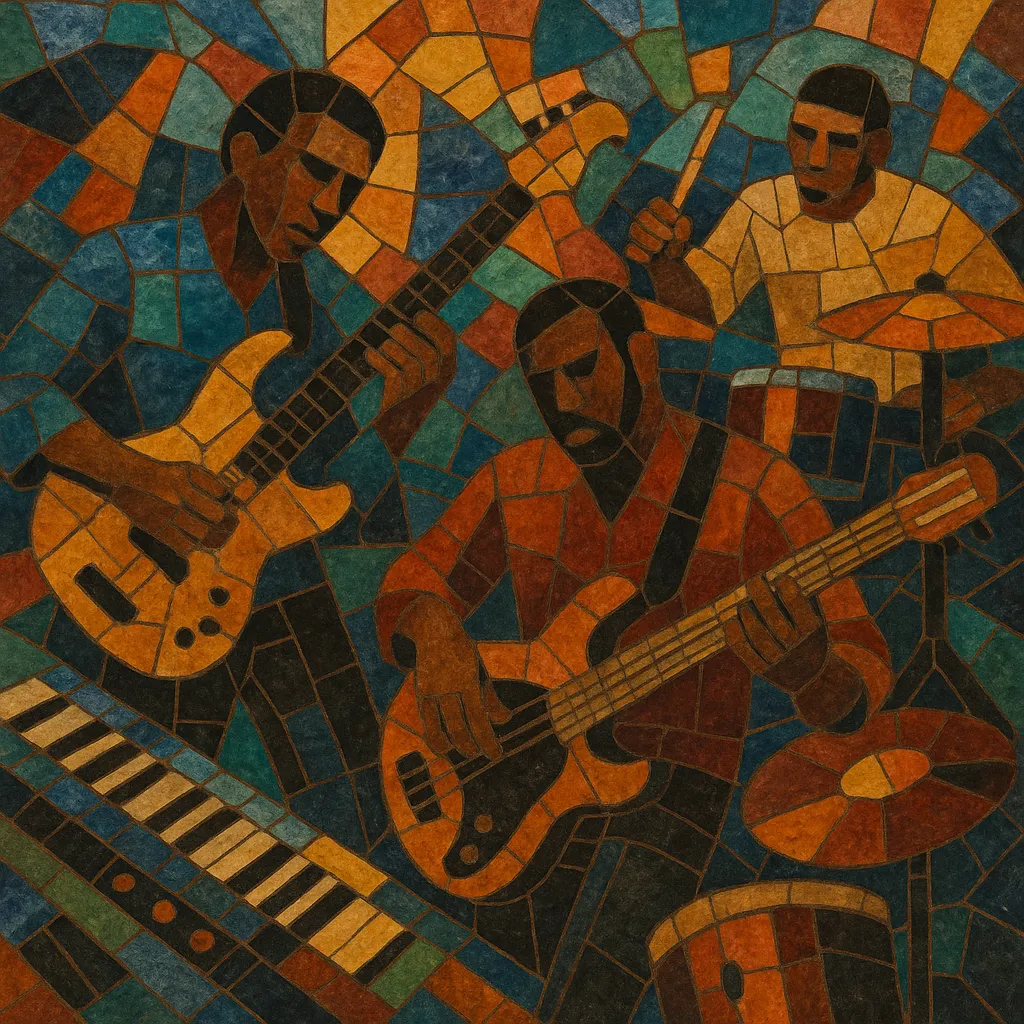Jazz fusion (often simply called "fusion") blends the improvisational language and harmonic richness of jazz with the amplified instruments, grooves, and song forms of rock, funk, and R&B. It typically features electric guitars, electric bass or fretless bass, Rhodes electric piano, clavinet, analog and digital synthesizers, and a drum kit playing backbeat- and syncopation-heavy patterns.
Hallmarks include extended chords and modal harmony, complex and shifting meters, brisk unison lines, virtuosic improvisation, and a production aesthetic that embraces effects processing and studio craft. The style ranges from fiery, aggressive workouts to polished, atmospheric textures, often within the same piece.
Emerging in the late 1960s and flourishing through the 1970s, jazz fusion became a bridge between jazz audiences and rock/funk listeners, shaping later styles such as jazz-funk, smooth jazz, nu jazz, and parts of progressive and technical rock/metal.
Jazz fusion crystallized when jazz musicians began adopting electric instruments and rock/funk rhythms. Miles Davis’s In a Silent Way (1969) and Bitches Brew (1970) were watershed recordings, expanding modal and collective improvisation over vamps and rock backbeats. Tony Williams’s Lifetime (Emergency!, 1969) paralleled this shift with a raw, power-trio intensity, while the psychedelic rock and soul scenes normalized amplification and studio experimentation.
The early-to-mid 1970s saw an explosion of bands that established the idiom’s sound and vocabulary. John McLaughlin’s Mahavishnu Orchestra fused Indian rhythmic ideas, odd meters, and blazing electric guitar with jazz harmony. Weather Report (cofounded by Joe Zawinul and Wayne Shorter) emphasized tone color, groove, and collective texture, later achieving crossover success with Heavy Weather (1977). Chick Corea’s Return to Forever drew on Latin influences and virtuoso ensemble writing, while Herbie Hancock’s Head Hunters (1973) anchored jazz improvisation within deep funk. Bass innovation (Jaco Pastorius’s singing, fretless tone and harmonics) and drumming breakthroughs (Billy Cobham, Lenny White, Tony Williams) became central to the style.
As fusion matured, it diversified. Some strands leaned toward accessible melodies and radio-ready production, laying groundwork for smooth jazz. Others emphasized lyrical, atmospheric writing—exemplified by the Pat Metheny Group—integrating world-music colors and evolving synthesizer technologies. Studio craft (multi-tracking, effects, and precise editing) became integral, while virtuosic soloists pushed technique on guitar, keyboards, and bass.
Fusion’s DNA spread widely: nu jazz blended electronic production with jazz harmony; jazz-funk resurfaced with modern sheen; jazz rap sampled fusion textures; and progressive/technical rock and metal adopted fusion’s rhythmic complexity and instrumental virtuosity. Contemporary ensembles (e.g., Snarky Puppy, Kneebody) and international scenes folded local traditions into the fusion toolkit. Today, fusion denotes both a historical style and a continuing practice of merging jazz with amplified, groove-forward, and technologically savvy approaches.
Use electric and electronic timbres: Fender Rhodes or Wurlitzer electric piano, clavinet, analog/digital synths (pads, leads, basses), electric or fretless bass, and electric guitar with effects (overdrive, delay, chorus, wah, envelope filter). A rock-oriented drum kit anchors the groove, often augmented by Latin or world percussion.
Build grooves from rock and funk backbeats (strong 2 and 4) with syncopated hi-hats and ghost notes. Explore odd meters (5/4, 7/8, 9/8) and metric modulations; layer polyrhythms between drums, bass, and comping instruments. Vamps (one- or two-chord ostinati) provide stable platforms for extended solos.
Employ extended and altered chords (9ths, 11ths, 13ths), modal progressions (Dorian, Mixolydian, Lydian), quartal/quintal voicings, and pedal points. Write strong, singable themes and tight unison/riff figures for guitar, keys, and sax. Contrast modal sections with more functional harmonic moments for narrative shape.
Common forms include head–solos–head, multi-part suites with tempo/meter shifts, and vamp-based codas. Arrange dynamic arcs: sparse textures that build to high-intensity ensemble lines, trading fours, and drum features. Use breaks, hits, and shout sections to cue transitions.
Soloists should combine jazz phrasing with rock energy: modal lines, outside playing over static harmony, rhythmic displacement, and motivic development. Encourage interactive comping—keyboards and guitar respond to the soloist and rhythm section in real time.
Capture punchy drums and articulate bass (DI + amp blend); let the Rhodes/synths occupy warm midrange with tasteful saturation. Use stereo imaging for ensemble clarity and automation for dynamic builds. Effects (delay, modulation, filters) can be part of the composition, not just decoration.


